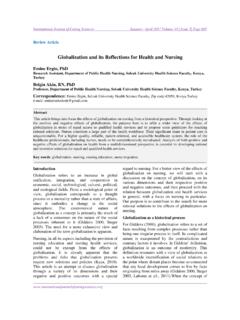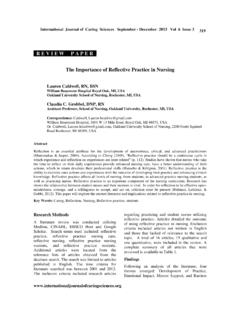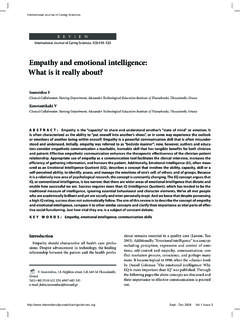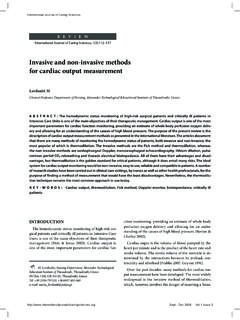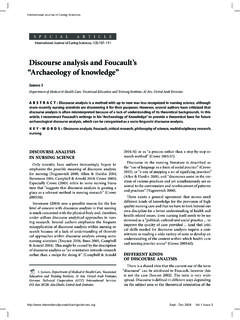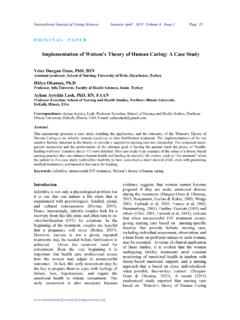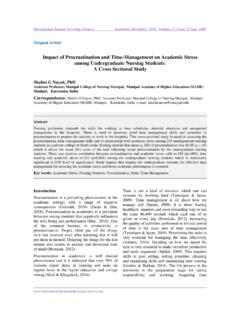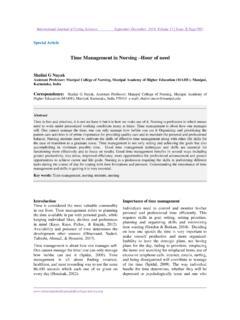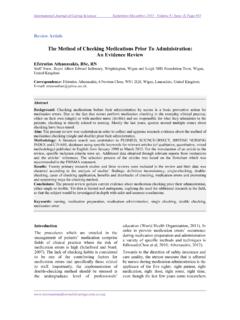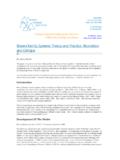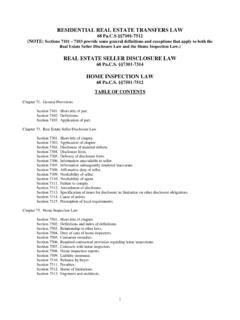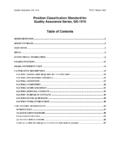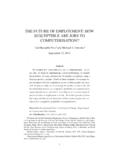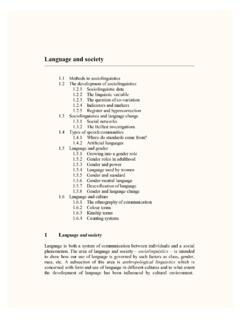Transcription of Designing Nursing Care Program Based on Johnson …
1 International Journal of Caring Sciences January-April 2018 Volume 11 | Issue 1| Page 631 Case Study Designing Nursing Care Program Based on Johnson behavioral Model in Children with Acute Lymphoblastic Leukemia: A Case Study Atefeh Ghanbari, PhD Associate Professor, Social Determinants of Health Research Center, Guilan University of Medical Sciences, Iran Somayeh Pouy, Children's Nursing Postgraduate Student Faculty of Nursing Midwifery of martyr Beheshti University of Rasht, Iran Correspondence: Somayeh Pouy, Children's Nursing Postgraduate Student Faculty of Nursing Midwifery of martyr Beheshti University of Rasht,Iran E-mail: Abstract Background: Johnson behavioral model can be easily implemented in clinic and the nurses can easily design and implement an appropriate care plan using this pattern for patients.
2 Aim: this paper has been developed aiming to investigate clinical function of Johnson behavioral model in the child suffering from Acute Lymphoblastic Leukemia (ALL) in an environment. Methodology: this paper is a case study one in which Nursing process has been used according to Johnson behavioral model in the child suffering from ALL. Result: in this paper after implementing care pan Based on Johnson model, we have reached the considered goals easily. Conclusion: The child who has been studied in this paper shows the application of Nursing process Based on Johnson behavioral theory in a clinic in a more expanded environment. Johnson behavioral theory is related to clinical environments and can be used in hospitals as a framework for diagnosing the problems of patient and proposing and evaluating comprehensive Nursing care.
3 Keywords: clinical skill, Johnson behavioral model, Nursing process, theory-clinical gap Introduction One of the persistent problems in Nursing is the existence of weak clinical observations and very little relationship of assumption concept in clinical environments. There are few studies about the function of theories in Nursing clinical skills. Moreover, it is imagined that Nursing theories are abstract and have a limited function in practice (Rolfe, 1993). Using theoretical researches as a clinical witness for critical thinking and decision-making, Nurses will increase their professional ability. When the nurses use theory and the evidences Based on theory in order to form their skills, it will lead to improving the quality of taking care of patient (Younas Ahtisham et al, 2015).
4 Implementing Nursing skills in clinical environment help the students and nurses to promote their critical thinking and analysis skills (Meleis, 2012; Fawcett, 2006). A care plan has been designed in this paper according to Johnson behavioral model in order to take care of the child suffering from ALL. Introduction to leukemia in children Leukemia is an expanded word which refers to a big group of malignant disease of the bone marrow and lymphatic system. Leukemia means unlimited proliferation of immature white blood cells in the blood-producing tissue. Two types of leukemia have been known in children: Acute Lymphoblastic Leukemia and Acute Myeloid Leukemia. Acute Lymphoblastic Leukemia (ALL) in children is of the most frequent childhood cancers.
5 The peak age of onset of this disease is International Journal of Caring Sciences January-April 2018 Volume 11 | Issue 1| Page 632 within 2 to 5 years old. Three main consequences of this disease include infections, fever and bleeding. The most common symptoms of leukemia in children are fever, paleness, fatigue, anorexia, bleeding and bone and joint pain. One of challenging situations in Nursing cares is taking care of children with cancer (Wong, 2015). Johnson behavioral System Model Johnson behavioral theory is affected by Nightingale s opinion. He believed that the aim of Nursing is helping people to prevent or ameliorate diseases or injuries. The science and art of Nursing should be concentrate on a patient not on certain patients.
6 For theorizing, Johnson has used the principles of behaviorists in psychology and sociology. behavioral system theory is very similar to biologic system theory in which human has been introduced as a biologic system including biological sections and disease is considered resulting from the disruption of biological systems (Ghanbari, 2004). Main presumptions of Johnson theory include individual, Nursing , environment and health. Johnson considers individual as a behavioral system with purposeful, repetitive and patterned ways that causes his relationship with the environment. Environment includes all factors in which a part is related to individual s behavioral system and affects system as well. He categorizes the environment into two groups of internal and external environment.
7 Health includes adequate and effective performance of systems and their behavioral stability and balance. As an external force, Nursing causes organizing the behavior of patient. Nursing activities aren t dependent on physician but they are as complementary for Physician s measures (Marlain, 2015). The main concepts of Johnson behavioral model include: behavior, system, behavioral system, subsystems, balance and individual (Koshyar, 2008). The components of behavioral system are called subsystems. Subsystems conduct specialized tasks leading to whole integration of behavioral system and manage the relationship between system and environment. Johnson has defined seven subsystems in his theory but according to Grubbs model, there are eight subsystems for operationalizing Johnson behavioral model which include Eliminative, Dependency, Aggressive/Protective, Affiliative, Achievement, Restorative, Ingestive and sexual.
8 Each subsystem has at least four structural components which involve goal, set, choice and action (Marlain, 2015; Alligood, 2014). Goal is the same reason and incentive of a subsystem s behaviors. Set is tendency which refers to the set of natural, regular and norm behaviors that an individual does to meet his needs. In Choice, among available options for achieving the goal, the individual chooses one. Action is a reaction that is shown by system against the incentive (Fawcett, 2006). Each one of subsystems has three equal functional needs which include stimulation, protection and nurturance. due to each subsystem maintain its stability, these functional needs should be met permanently by environment but at sickness or health threatening conditions, the nurse is a resource for providing these functional needs (Alligood, 2014).
9 Johnson considers Nursing different from medicine because Nursing sees patient as behavioral system and medicine sees patient as biological system (Marlain, 2015). Nursing process is used in Johnson behavioral model that is the emerge of disorder in behavior or sudden change in internal or external environment will lead to disorder in performance. Johnson believes that initial Nursing investigation starts when pressure symptom or lack of balance is observed (Ghanbari, 2004). Johnson didn t emphasize on Nursing process levels but he obviously considered the role of nurse as an external adjustment factor (Marlain, 2015). Nursing diagnoses are in four categories according to Johnson behavioral model which include: dominance, incompatibility, insufficiency and discrepancy.
10 Nursing interventions are specified Based on Johnson behavioral model with dominance, incompatibility, insufficiency and discrepancy. These interventions include providing subsystems by external mechanisms of Facilitate, Inhibit, Restrict and Defend (Meleis, 2012). A case study The patient under study is an eleven-year-old girl named Zeinab. M, in first grade of secondary school who has been hospitalized in infection center because of fever since 29/10/2016. International Journal of Caring Sciences January-April 2018 Volume 11 | Issue 1| Page 633 According to her mother, she had nosebleeds two month ago and after a few days because of lower blood pressure and high fever, they referred to the hospital.
